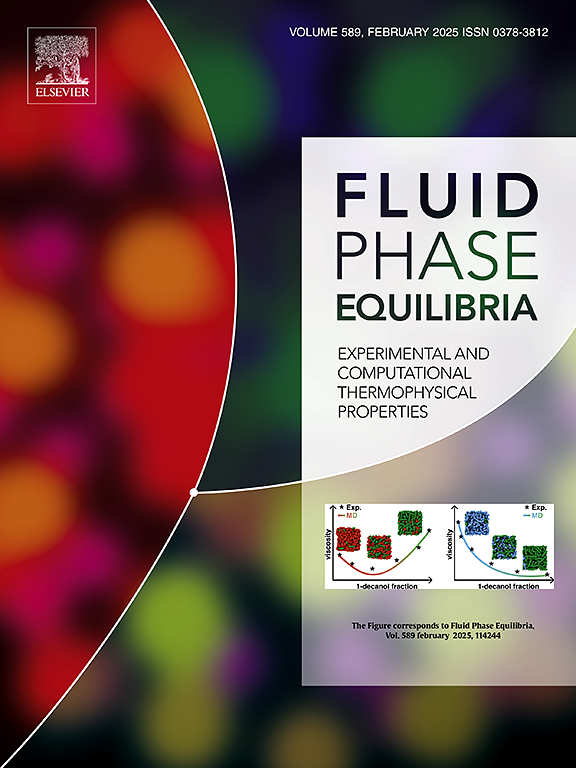丙酮+ CO2体系的气液界面性质:实验、分子模拟、密度梯度理论和密度泛函理论
IF 2.7
3区 工程技术
Q3 CHEMISTRY, PHYSICAL
引用次数: 0
摘要
采用垂坠实验以及分子动力学(MD)模拟、密度梯度理论(DGT)和密度泛函理论(DFT)等多种理论方法研究了丙酮+ CO2体系的气液界面性质。在303.15 ~ 373.15 K的温度范围内,测定了CO2的相对吸附量和表面张力。实验结果与三种理论方法的预测结果进行了比较,这也提供了对界面结构的见解,以及对CO2界面富集和界面厚度的数据,这是单独实验无法实现的。三种理论方法的计算结果与实验结果基本一致。此外,利用MD、DGT和DFT研究了界面处的纳米结构。本文章由计算机程序翻译,如有差异,请以英文原文为准。
Vapor–liquid interfacial properties of the system acetone + CO2: Experiments, molecular simulation, density gradient theory, and density functional theory
Vapor–liquid interfacial properties of the system acetone + CO were studied using pendant drop experiments as well as multiple theoretical approaches, namely molecular dynamics (MD) simulations, density gradient theory (DGT), and density functional theory (DFT). The surface tension as well as relative adsorption of CO were obtained from the experiments for temperatures between 303.15 K and 373.15 K. The experimental results were compared to predictions from the three theoretical approaches, which also provide insights into the structure of the interface and data on the interfacial enrichment of CO and the interfacial thickness, which is not feasible by the experiments alone. The results from all three theoretical approaches are found to be in good mutual agreement as well as in agreement with the experimental results. Additionally, MD, DGT, and DFT were used to study the nanoscopic structure at the interface.
求助全文
通过发布文献求助,成功后即可免费获取论文全文。
去求助
来源期刊

Fluid Phase Equilibria
工程技术-工程:化工
CiteScore
5.30
自引率
15.40%
发文量
223
审稿时长
53 days
期刊介绍:
Fluid Phase Equilibria publishes high-quality papers dealing with experimental, theoretical, and applied research related to equilibrium and transport properties of fluids, solids, and interfaces. Subjects of interest include physical/phase and chemical equilibria; equilibrium and nonequilibrium thermophysical properties; fundamental thermodynamic relations; and stability. The systems central to the journal include pure substances and mixtures of organic and inorganic materials, including polymers, biochemicals, and surfactants with sufficient characterization of composition and purity for the results to be reproduced. Alloys are of interest only when thermodynamic studies are included, purely material studies will not be considered. In all cases, authors are expected to provide physical or chemical interpretations of the results.
Experimental research can include measurements under all conditions of temperature, pressure, and composition, including critical and supercritical. Measurements are to be associated with systems and conditions of fundamental or applied interest, and may not be only a collection of routine data, such as physical property or solubility measurements at limited pressures and temperatures close to ambient, or surfactant studies focussed strictly on micellisation or micelle structure. Papers reporting common data must be accompanied by new physical insights and/or contemporary or new theory or techniques.
 求助内容:
求助内容: 应助结果提醒方式:
应助结果提醒方式:


